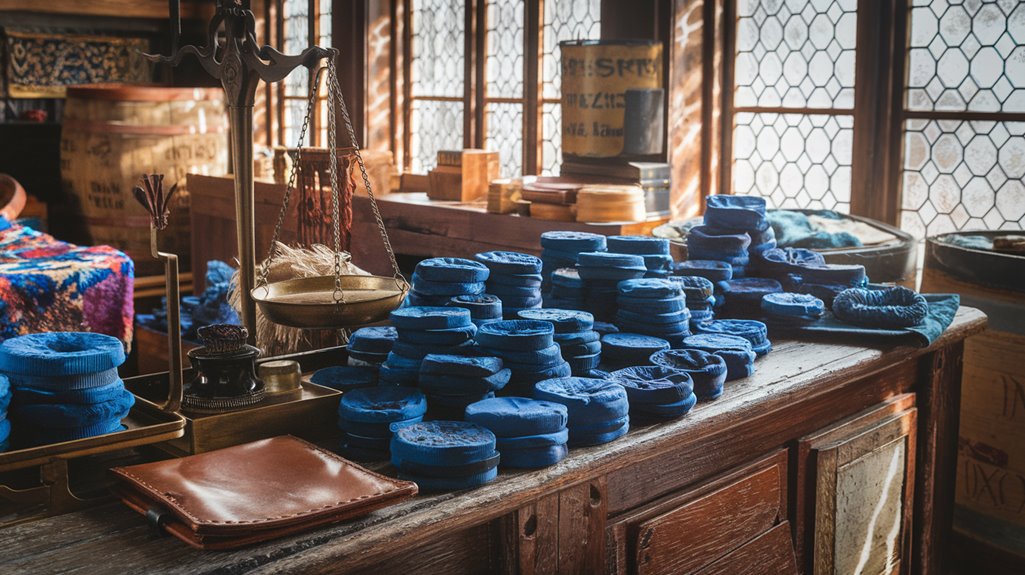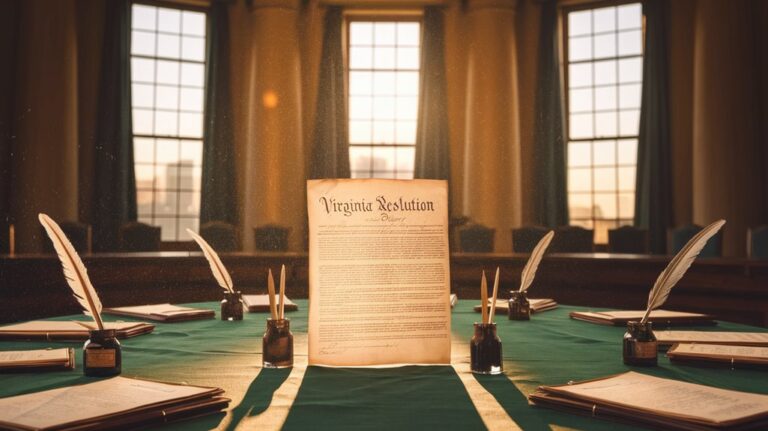Indigo Was Used as Currency in Colonial America
You might think money has always been green, but there was a time when blue ruled the colonial economy. When you look at South Carolina's 18th-century trade system, you'll find that indigo wasn't just a dye – it was as good as gold. The explosive growth from 138,300 pounds to over a million pounds in less than three decades transformed this deep blue powder into a powerful currency that merchants couldn't resist. There's more to this colorful story that might change how you see colonial commerce.
The Rise of "Blue Gold" in Colonial South Carolina

While most colonial crops took years to establish, indigo's meteoric rise in South Carolina transformed the colony's economy almost overnight.
When farmers first experimented with indigo cultivation in the 1740s, they discovered the region's warm climate was perfect for growing this valuable crop.
You'll be amazed to learn that within just seven years of its introduction, South Carolina was exporting over 138,000 pounds of indigo to Britain.
Eliza Lucas was instrumental in developing successful indigo cultivation methods at just sixteen years old.
By 1775, that number had skyrocketed to more than 1.1 million pounds, making it the colony's second-largest cash crop.
The British government bounty of 1749 helped drive this remarkable growth by providing financial incentives to colonial farmers.
The plantation economy boomed as wealthy landowners added indigo alongside their rice fields, though this prosperity came at a terrible human cost.
The industry relied heavily on enslaved Africans, whose expertise and forced labor fueled the explosive growth of "blue gold."
From Plant to Trade: How Indigo Became Colonial Currency
The transformation of indigo from a simple plant to a powerful form of colonial currency reveals one of early America's most fascinating economic stories.
As you'd discover in colonial South Carolina, indigo cultivation grew from a modest 138,300 pounds in 1747 to over a million pounds by 1775, establishing itself as the colony's second-largest export.
Modern artisans and farmers are now reviving this historically significant crop in South Carolina. The trading practices surrounding indigo made it especially valuable as currency. You could find planters using indigo to purchase goods, settle debts, and expand their operations.
Since England's clothing industry demanded vast quantities of the blue dye, merchants readily accepted it as payment. Documents from the South Carolina Gazette frequently reported on indigo's use in commerce and trade.
The crop's ability to grow on land unsuitable for rice made it doubly valuable, allowing plantation owners to maximize their resources and build unprecedented wealth in the American colonies.
The Economic Power Behind South Carolina's Blue Dye
Since South Carolina's indigo exports reached an astounding 1.1 million pounds by 1775, you'd understand why colonists called it "blue gold." This valuable commodity helped make South Carolina the wealthiest American colony in the mid-1700s, with exports worth over $40 million in today's currency.
The economic significance of indigo production can't be overstated – it was South Carolina's second-largest cash crop after rice. African traditions stretching back six thousand years influenced the cultivation and processing methods used in colonial America.
When King George's War disrupted rice trade in the late 1730s, indigo production surged to fill the economic gap. From the 1740s to 1790s, this blue dye dominated the colony's economy and became England's primary source for textile coloring.
The industry's success relied heavily on skilled enslaved workers who mastered the complex process of converting indigo leaves into this prized trading commodity. Today, farmers like Kathy McCullough are reviving this historical crop through sustainable production methods, testing various cultivation techniques to optimize yields.
African Knowledge and the Indigo Trade Empire
Behind South Carolina's explosive indigo trade stood the unsung expertise of enslaved Africans, whose technical knowledge and skilled labor transformed the colony into Britain's primary source of blue dye.
Their African innovations and cultural practices were essential to the industry's success, drawing from generations of experience in West African indigo cultivation. The intensive labor required fifteen skilled workers for every fifty acres of indigo cultivation. The crop became so valuable that it was often referred to as blue gold in colonial trade.
You'll discover these remarkable contributions to the indigo empire:
- Precise fermentation timing that determined dye quality
- Specialized agitation techniques passed down through generations
- Complex extraction methods that maximized dye yield
- Advanced soil preparation strategies for optimal plant growth
This knowledge wasn't just manual labor – it represented sophisticated technical expertise that plantation owners depended on.
Legacy of the Colonial Indigo Market System

While South Carolina's indigo trade created unprecedented colonial wealth, its legacy reveals a complex intersection of economic triumph and human exploitation.
You'll find that indigo cultivation transformed colonial economies, with production surging from 63,000 pounds in 1750 to over one million pounds by 1775. This boom made Carolina planters the wealthiest colonial elite on the Atlantic seaboard.
Workers faced severe health risks as the toxic processing methods made many ill during the labor-intensive extraction process. The economic exploitation of enslaved African workers, who provided the intensive labor for planting, processing, and producing indigo, fueled the trade's success.
Their skilled work, from building processing vats to determining precise fermentation times, was essential yet undervalued. The industry's collapse during the American Revolution exposed how deeply the colonial economy relied on both slave labor and British markets.










